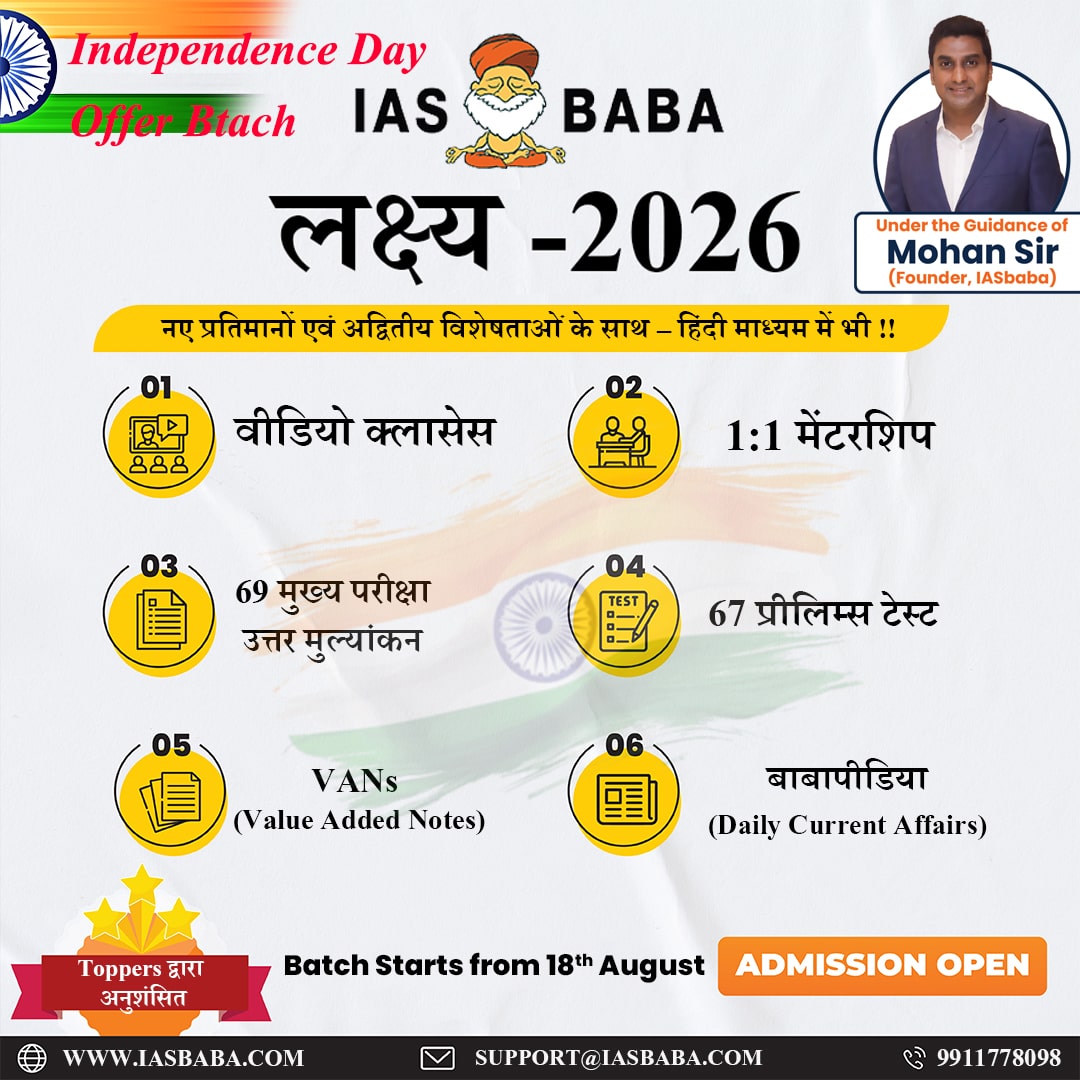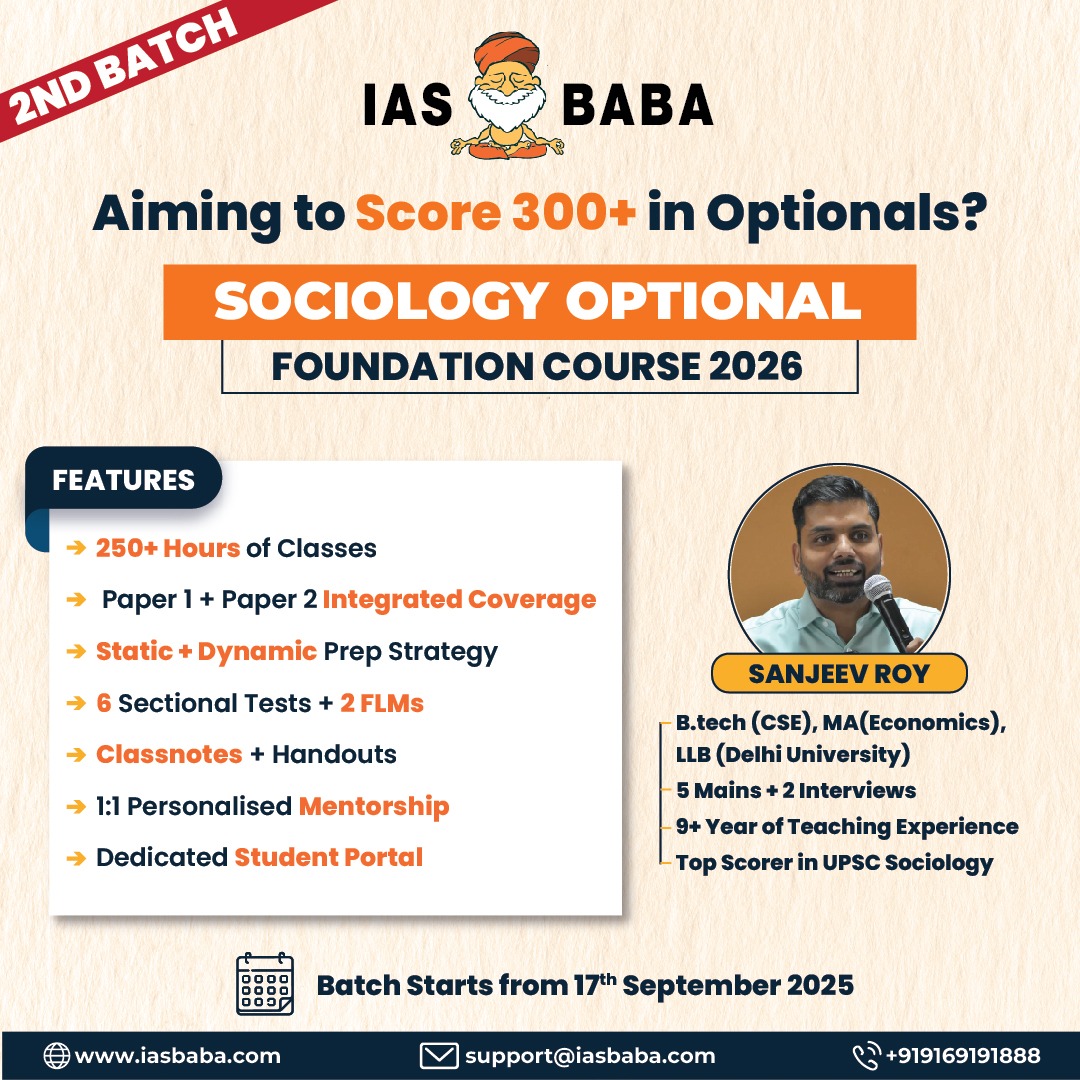IASbaba Daily Prelims Quiz
For Previous Daily Quiz (ARCHIVES) – CLICK HERE
The Current Affairs questions are based on sources like ‘The Hindu’, ‘Indian Express’ and ‘PIB’, which are very important sources for UPSC Prelims Exam. The questions are focused on both the concepts and facts. The topics covered here are generally different from what is being covered under ‘Daily Current Affairs/Daily News Analysis (DNA) and Daily Static Quiz’ to avoid duplication. The questions would be published from Monday to Saturday before 2 PM. One should not spend more than 10 minutes on this initiative.
Gear up and Make the Best Use of this initiative.
Do remember that, “the difference between Ordinary and EXTRA-Ordinary is PRACTICE!!”
Important Note:
- Don’t forget to post your marks in the comment section. Also, let us know if you enjoyed today’s test 🙂
- After completing the 5 questions, click on ‘View Questions’ to check your score, time taken, and solutions.
Test-summary
0 of 5 questions completed
Questions:
- 1
- 2
- 3
- 4
- 5
Information
To view Solutions, follow these instructions:
- Click on – ‘Start Test’ button
- Solve Questions
- Click on ‘Test Summary’ button
- Click on ‘Finish Test’ button
- Now click on ‘View Questions’ button – here you will see solutions and links.
You have already completed the test before. Hence you can not start it again.
Test is loading...
You must sign in or sign up to start the test.
You have to finish following test, to start this test:
Results
0 of 5 questions answered correctly
Your time:
Time has elapsed
You have scored 0 points out of 0 points, (0)
| Average score |
|
| Your score |
|
Categories
- Not categorized 0%
| Pos. | Name | Entered on | Points | Result |
|---|---|---|---|---|
| Table is loading | ||||
| No data available | ||||
- 1
- 2
- 3
- 4
- 5
- Answered
- Review
-
Question 1 of 5
1. Question
Exercise Ekatha is a bilateral military exercise conducted between India and which country?
Correct
Solution (a)
Explanation:
• Exercise Ekatha is a bilateral military exercise conducted between the armed forces of India and Maldives, aimed at enhancing joint operational capabilitiesIncorrect
Solution (a)
Explanation:
• Exercise Ekatha is a bilateral military exercise conducted between the armed forces of India and Maldives, aimed at enhancing joint operational capabilities -
Question 2 of 5
2. Question
Consider the following statements regarding Project Mausam:
- It was launched by the Ministry of Culture.
- The project focuses on monsoon patterns as a unifying factor shaping cultural, economic, and trade exchanges across regions.
- it aims to seek UNESCO World Heritage status exclusively for inland archaeological sites in India.
How many of the above statements is/are correct?
Correct
Solution (b)
Explanation:
• Project Mausam is an initiative of the Ministry of Culture aimed at reviving and strengthening India’s ancient maritime and cultural linkages across the Indian Ocean world. Hence Statement 1 is Correct
• The project uses the monsoon (mausam) as a conceptual framework to understand historical navigation, trade, and cultural interactions. Hence Statement 2 is Correct
• The project is not limited to inland sites; it also emphasizes coastal routes, ports, and transnational maritime heritage. Hence Statement 3 is IncorrectIncorrect
Solution (b)
Explanation:
• Project Mausam is an initiative of the Ministry of Culture aimed at reviving and strengthening India’s ancient maritime and cultural linkages across the Indian Ocean world. Hence Statement 1 is Correct
• The project uses the monsoon (mausam) as a conceptual framework to understand historical navigation, trade, and cultural interactions. Hence Statement 2 is Correct
• The project is not limited to inland sites; it also emphasizes coastal routes, ports, and transnational maritime heritage. Hence Statement 3 is Incorrect -
Question 3 of 5
3. Question
- Consider the following statements regarding Vellode Bird Sanctuary:
- Vellode Bird Sanctuary is located in Tamil Nadu and is known for attracting migratory birds during the winter season.
- The sanctuary is situated in the Western Ghats and forms part of a high-altitude forest ecosystem.
Which of the statements given above is/are correct?
Correct
- Solution (a)
Explanation:
• Vellode Bird Sanctuary is located near Erode in Tamil Nadu and serves as an important wetland habitat for resident and migratory birds, especially during winter. Hence Statement 1 is Correct
• The sanctuary is a lowland freshwater wetland and is not part of the Western Ghats high-altitude forest ecosystem. Hence Statement 2 is IncorrectIncorrect
- Solution (a)
Explanation:
• Vellode Bird Sanctuary is located near Erode in Tamil Nadu and serves as an important wetland habitat for resident and migratory birds, especially during winter. Hence Statement 1 is Correct
• The sanctuary is a lowland freshwater wetland and is not part of the Western Ghats high-altitude forest ecosystem. Hence Statement 2 is Incorrect -
Question 4 of 5
4. Question
- Consider the following statements regarding Ramappa Temple:
- It is located in Telangana and was built during the Kakatiya dynasty.
- The temple is dedicated to Lord Shiva and is also known as the Rudreshwara Temple.
- It was inscribed as a UNESCO World Heritage Site under the category of “Sacred Ensembles of the Hoysalas.”
Which of the statements given above is/are correct?
Correct
- Solution (b)
Explanation:
• Ramappa Temple is situated in Mulugu district of Telangana and was constructed in the 13th century under the patronage of the Kakatiya rulers. Hence Statement 1 is Correct
• The temple is dedicated to Lord Shiva and is historically known as the Rudreshwara Temple. Hence Statement 2 is Correct
• Ramappa Temple was inscribed as a UNESCO World Heritage Site under the “Kakatiya Rudreshwara (Ramappa) Temple” category, not under the Hoysala temples. Hence Statement 3 is IncorrectIncorrect
- Solution (b)
Explanation:
• Ramappa Temple is situated in Mulugu district of Telangana and was constructed in the 13th century under the patronage of the Kakatiya rulers. Hence Statement 1 is Correct
• The temple is dedicated to Lord Shiva and is historically known as the Rudreshwara Temple. Hence Statement 2 is Correct
• Ramappa Temple was inscribed as a UNESCO World Heritage Site under the “Kakatiya Rudreshwara (Ramappa) Temple” category, not under the Hoysala temples. Hence Statement 3 is Incorrect -
Question 5 of 5
5. Question
- Consider the following statements regarding Dieback disease:
- Dieback disease refers to a condition in which plants show progressive death of shoots, branches, or roots, often starting from the tips.
- Dieback disease is caused exclusively by viral pathogens and cannot result from environmental stress factors.
Which of the statements given above is/are correct?
Correct
- Solution (a)
Explanation:
• Dieback is a general plant disease condition characterized by the gradual drying and death of plant parts, commonly observed in trees and woody plants. Hence Statement 1 is Correct
• Dieback can be caused by multiple factors such as fungal pathogens, insect infestation, nutrient deficiency, drought, and other environmental stresses; it is not limited to viral causes. Hence Statement 2 is IncorrectIncorrect
- Solution (a)
Explanation:
• Dieback is a general plant disease condition characterized by the gradual drying and death of plant parts, commonly observed in trees and woody plants. Hence Statement 1 is Correct
• Dieback can be caused by multiple factors such as fungal pathogens, insect infestation, nutrient deficiency, drought, and other environmental stresses; it is not limited to viral causes. Hence Statement 2 is Incorrect
- Current Affairs Quiz, IAS Daily Current Affairs Quiz, IAS UPSC Current Affairs Quiz, IAS UPSC Prelims Quiz, IASbaba's Current Affairs Prelims Quiz, IASbaba's Daily Quiz, IASbaba's UPSC Quiz, Prelims Current Affairs Quiz, UPSC Current Affairs Quiz, UPSC Current Affairs Quiz IASbaba, UPSC Daily Current Affair Quiz, UPSC IAS Daily Quiz













